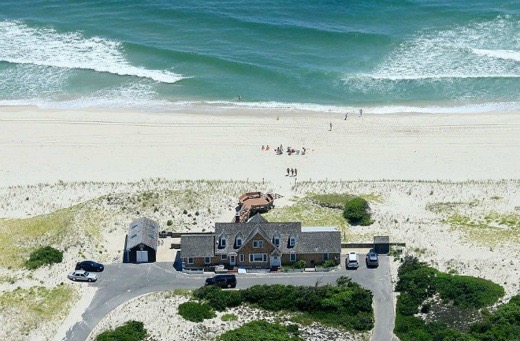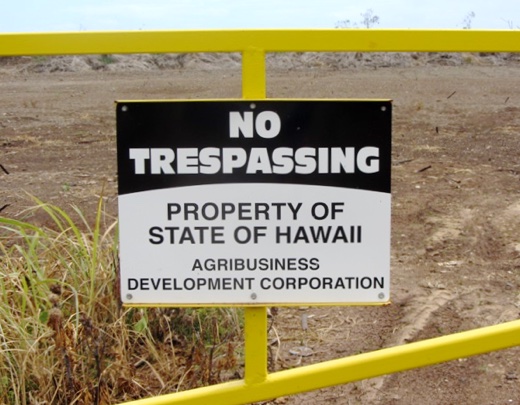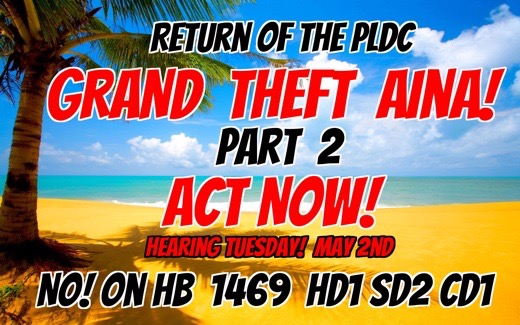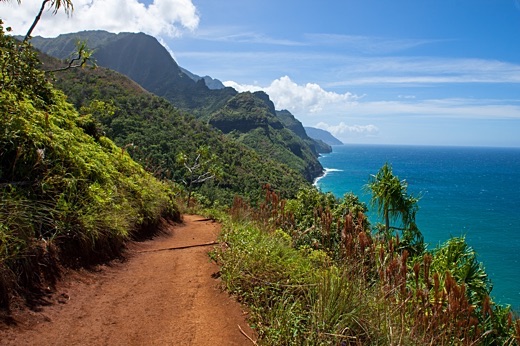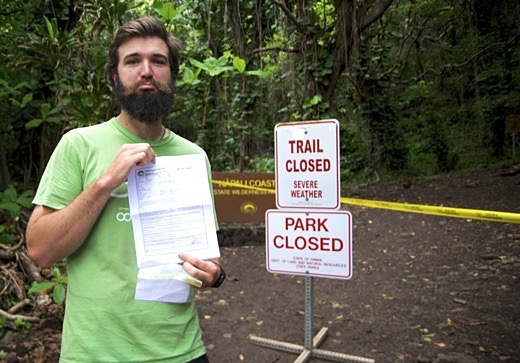SUBHEAD: Climate change and ocean rise is forcing difficult choices on Hawaii now.
By Nathan Eagle on 28 July 2017 for Civic Beat -
(http://www.civilbeat.org/2017/07/save-beaches-or-property-climate-change-will-force-tough-choices/)
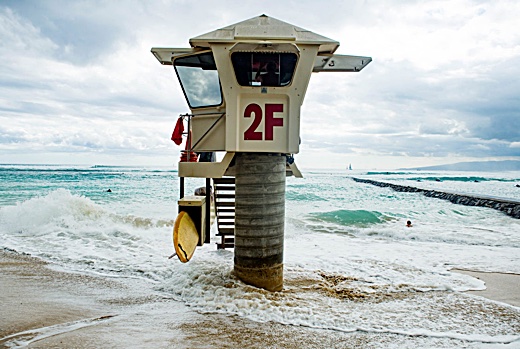
Image above: A Waikiki lifeguard station surrounded by ocean water is barely operational today. From original article promo.
A coastal hazard expert briefs Hawaii officials and others about the need to adapt to rising sea levels and warmer temperatures.
With the impacts of climate change bearing down on Hawaii, government officials and community members need to make some important decisions about the islands’ iconic coastlines, said Dolan Eversole, a coastal hazards expert with the University of Hawaii’s Sea Grant program.
“That’s the policy question that we’re faced with now — what’s more important, protecting the property or protecting the beach?” he said. “It’s not a simple answer.”
Eversole was addressing a roomful of state and county officials, nonprofit leaders and others Thursday at the annual State of Hawaii Drowning Prevention and Ocean Safety Conference at the Hawaii Convention Center in Honolulu.
Even under conservative projections, he said Hawaii will have to adapt to a suite of issues that are exacerbated by increasing temperatures and rising sea levels, including coastal erosion, hurricanes, tsunamis, high surf, high winds and flooding.
“Climate change is not necessarily an independent problem,” Eversole said. “It’s going to overlie the problems that we have and in many cases make them worse.”
The “king tides” that caused flooding in Waikiki and other parts of the state this summer were in many ways a glimpse into the future, he said.
It’s not all doom and gloom though, at least compared to other coastal states like Florida and Louisana that are also being forced to adapt to climate change.
Hawaii has the advantage of topography, Eversole said. Elevations increase quickly in the mountainous islands, so adapting for some can mean moving to the other side of Kamehameha Highway, which wraps around Oahu’s northern coast.
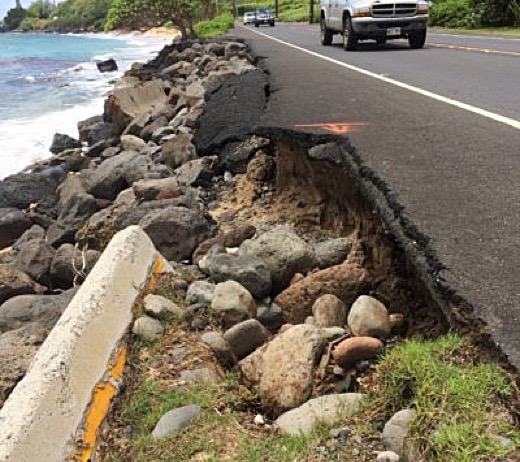
Image above: Coastal highway on north shore of Oahu threatened by high ocean waves. From original article.
“It’s going to be inconvenient but we won’t have to go too far,” he said, underscoring how that’s not even an option in some other places.
Eversole is also heartened by Hawaii having a climate adaptation plan underway. The first part of that plan, due in December, will show how sea-level rise will likely affect hotels, homes and other properties in the coming decades.
Honolulu Emergency Services Director Jim Howe, who was the city’s longtime ocean safety chief, said the city has much of the necessary information and has started to respond.
He said the newly created Office of Climate Change, Resilience and Sustainability has held its first major gathering of stakeholders to gain input. A full report from that meeting with roughly 350 individuals from businesses, nonprofits, government and environmental groups is coming, he said, but the preliminary results illustrate the need to focus on the coastal areas and infrastructure.
“We’re going to have to make some priority decisions,” Howe said. “Where are we going to best spend our money? What is going to be the best approach for us as a community? That’s a dialogue that we need to have.”
He said Hawaii has to brace for weather impacts, from increased flooding to more frequent hurricanes.
“All of us in the community need to be prepared,” Howe said. “The more we can be proactive, the better off we’re going to be in the end.”
There’s a lot at stake. Hawaii’s economy largely depends on millions of tourists coming to visit its famed beaches.
Hospitality Advisors, a consulting firm, estimated Waikiki Beach alone contributes more than $2 billion in visitor spending annually.
Waikiki Beach is already in need of millions of dollars of overdue work and there’s still no master plan for the beach, Eversole said.
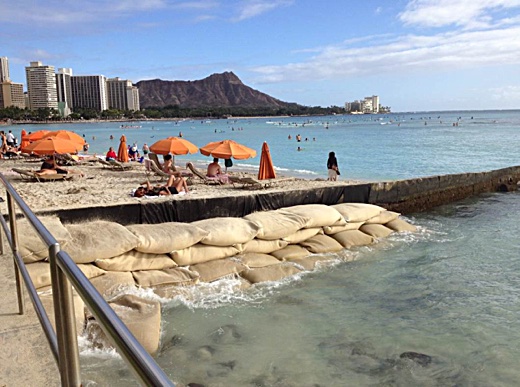
Image above: The beach at the Royal Hawaiian Hotel is under ocean waves that break against the hotel's porch railing. From original article promo.
And the adjacent Kuhio Beach is a “public safety emergency,” he said, noting how sections of the groin are collapsing in front of a mound where hula dancers perform.
“It’s a mess right now,” he said. “It’s the worst I’ve ever seen it.”
Studies are underway, including the state’s $800,000 Waikiki Beach Technical Feasibility Study, and public-private partnerships have formed to address the most serious problems.
The Waikiki Beach Special Improvement District Association is splitting a $1.5 million project with the state to fix the Royal Hawaiian groin, which Eversole said “literally holds together Waikiki Beach.”
Commercial properties pay a special tax that funds the association’s projects, which are all focused on beach management.
Construction may not begin for two years, though, due to permit requirements, Eversole said.
“Hawaii is probably one of the most vulnerable areas to coastal hazards in the world,” he said.
This is not the first time Eversole has waved flags trying to alert the public and policymakers to the problems Hawaii faces due to climate change.
He was lead author of a 2014 UH Sea Grant report, funded by the Hawaii Tourism Authority, that details the current and future effects of climate change in the islands.
Eversole said what concerns scientists the most are the extremes, not the averages, in terms of swings in temperatures and the rates of change.
The rate of warming air temperature in Hawaii has quadrupled in the last 40 years to more than 0.3 degrees Fahrenheit per decade. This causes stress for plants and animals, heat-related illnesses in humans and expanded ranges for pathogens and invasive species, he said.
“It could get exponential at some point in the future unless we do something about it,” he said.
When it comes to sea-level rise, the global average is 4 millimeters a year, but it’s not uniform. Low-lying atolls in the western Pacific are seeing 10-millimeter increases annually while Hawaii is averaging 1.5 millimeters a year.
Eversole said that Hawaii should not bank on its below-average increase because projections show it will greatly accelerate.
“Inarguably in the scientific community, climate change is real. There is no question,” he said. “The only question that surrounds climate change is what do we do about it. We’re in a catch-up mode.”
.
By Nathan Eagle on 28 July 2017 for Civic Beat -
(http://www.civilbeat.org/2017/07/save-beaches-or-property-climate-change-will-force-tough-choices/)

Image above: A Waikiki lifeguard station surrounded by ocean water is barely operational today. From original article promo.
A coastal hazard expert briefs Hawaii officials and others about the need to adapt to rising sea levels and warmer temperatures.
With the impacts of climate change bearing down on Hawaii, government officials and community members need to make some important decisions about the islands’ iconic coastlines, said Dolan Eversole, a coastal hazards expert with the University of Hawaii’s Sea Grant program.
“That’s the policy question that we’re faced with now — what’s more important, protecting the property or protecting the beach?” he said. “It’s not a simple answer.”
Eversole was addressing a roomful of state and county officials, nonprofit leaders and others Thursday at the annual State of Hawaii Drowning Prevention and Ocean Safety Conference at the Hawaii Convention Center in Honolulu.
Even under conservative projections, he said Hawaii will have to adapt to a suite of issues that are exacerbated by increasing temperatures and rising sea levels, including coastal erosion, hurricanes, tsunamis, high surf, high winds and flooding.
“Climate change is not necessarily an independent problem,” Eversole said. “It’s going to overlie the problems that we have and in many cases make them worse.”
The “king tides” that caused flooding in Waikiki and other parts of the state this summer were in many ways a glimpse into the future, he said.
It’s not all doom and gloom though, at least compared to other coastal states like Florida and Louisana that are also being forced to adapt to climate change.
Hawaii has the advantage of topography, Eversole said. Elevations increase quickly in the mountainous islands, so adapting for some can mean moving to the other side of Kamehameha Highway, which wraps around Oahu’s northern coast.

Image above: Coastal highway on north shore of Oahu threatened by high ocean waves. From original article.
“It’s going to be inconvenient but we won’t have to go too far,” he said, underscoring how that’s not even an option in some other places.
Eversole is also heartened by Hawaii having a climate adaptation plan underway. The first part of that plan, due in December, will show how sea-level rise will likely affect hotels, homes and other properties in the coming decades.
Honolulu Emergency Services Director Jim Howe, who was the city’s longtime ocean safety chief, said the city has much of the necessary information and has started to respond.
He said the newly created Office of Climate Change, Resilience and Sustainability has held its first major gathering of stakeholders to gain input. A full report from that meeting with roughly 350 individuals from businesses, nonprofits, government and environmental groups is coming, he said, but the preliminary results illustrate the need to focus on the coastal areas and infrastructure.
“We’re going to have to make some priority decisions,” Howe said. “Where are we going to best spend our money? What is going to be the best approach for us as a community? That’s a dialogue that we need to have.”
He said Hawaii has to brace for weather impacts, from increased flooding to more frequent hurricanes.
“All of us in the community need to be prepared,” Howe said. “The more we can be proactive, the better off we’re going to be in the end.”
There’s a lot at stake. Hawaii’s economy largely depends on millions of tourists coming to visit its famed beaches.
Hospitality Advisors, a consulting firm, estimated Waikiki Beach alone contributes more than $2 billion in visitor spending annually.
Waikiki Beach is already in need of millions of dollars of overdue work and there’s still no master plan for the beach, Eversole said.

Image above: The beach at the Royal Hawaiian Hotel is under ocean waves that break against the hotel's porch railing. From original article promo.
And the adjacent Kuhio Beach is a “public safety emergency,” he said, noting how sections of the groin are collapsing in front of a mound where hula dancers perform.
“It’s a mess right now,” he said. “It’s the worst I’ve ever seen it.”
Studies are underway, including the state’s $800,000 Waikiki Beach Technical Feasibility Study, and public-private partnerships have formed to address the most serious problems.
The Waikiki Beach Special Improvement District Association is splitting a $1.5 million project with the state to fix the Royal Hawaiian groin, which Eversole said “literally holds together Waikiki Beach.”
Commercial properties pay a special tax that funds the association’s projects, which are all focused on beach management.
Construction may not begin for two years, though, due to permit requirements, Eversole said.
“Hawaii is probably one of the most vulnerable areas to coastal hazards in the world,” he said.
This is not the first time Eversole has waved flags trying to alert the public and policymakers to the problems Hawaii faces due to climate change.
He was lead author of a 2014 UH Sea Grant report, funded by the Hawaii Tourism Authority, that details the current and future effects of climate change in the islands.
Eversole said what concerns scientists the most are the extremes, not the averages, in terms of swings in temperatures and the rates of change.
The rate of warming air temperature in Hawaii has quadrupled in the last 40 years to more than 0.3 degrees Fahrenheit per decade. This causes stress for plants and animals, heat-related illnesses in humans and expanded ranges for pathogens and invasive species, he said.
“It could get exponential at some point in the future unless we do something about it,” he said.
When it comes to sea-level rise, the global average is 4 millimeters a year, but it’s not uniform. Low-lying atolls in the western Pacific are seeing 10-millimeter increases annually while Hawaii is averaging 1.5 millimeters a year.
Eversole said that Hawaii should not bank on its below-average increase because projections show it will greatly accelerate.
“Inarguably in the scientific community, climate change is real. There is no question,” he said. “The only question that surrounds climate change is what do we do about it. We’re in a catch-up mode.”
.
